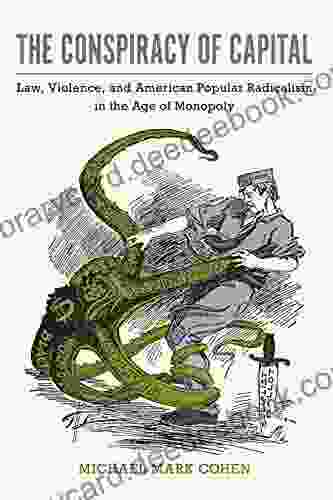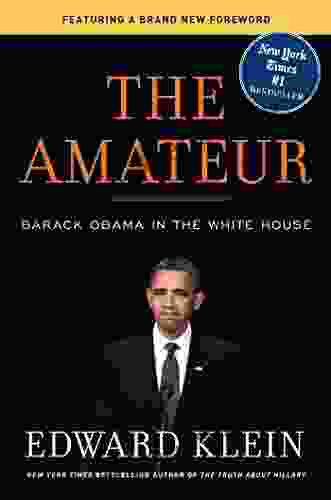Law, Violence, and American Popular Radicalism in the Age of Monopoly

The late nineteenth and early twentieth centuries were a time of great social and economic change in the United States. The rise of industrial capitalism led to the concentration of wealth and power in the hands of a few large corporations, and the working class faced increasing exploitation and violence. In response, a variety of radical movements emerged, including the labor movement, the socialist movement, and the anarchist movement.
4.6 out of 5
| Language | : | English |
| File size | : | 4265 KB |
| Text-to-Speech | : | Enabled |
| Screen Reader | : | Supported |
| Enhanced typesetting | : | Enabled |
| Word Wise | : | Enabled |
| Print length | : | 360 pages |
| X-Ray for textbooks | : | Enabled |
The law played a central role in shaping the development of these movements. The courts were used to suppress labor strikes, to deport radical activists, and to justify the use of violence against protesters. In response, radicals developed their own legal strategies, including the use of civil disobedience and the defense of free speech.
Violence was also a central feature of the era. The police and the military were used to suppress radical movements, and radicals often responded with violence of their own. This violence culminated in the Haymarket Affair of 1886, in which a bomb exploded at a labor rally in Chicago, killing seven police officers and four civilians. The aftermath of Haymarket led to a wave of repression against the labor movement and the anarchist movement.
Despite the repression, radical movements continued to grow in the early twentieth century. The labor movement won a number of important victories, including the eight-hour workday and the right to unionize. The socialist movement also gained ground, and in 1912, Eugene Debs won over 900,000 votes as the Socialist Party's candidate for president.
The entry of the United States into World War I in 1917 marked a turning point in the history of radicalism. The war led to a new wave of repression, and many radicals were arrested and imprisoned. After the war, the Red Scare of 1919-1920 led to the further suppression of radical movements.
The law, violence, and radicalism of the late nineteenth and early twentieth centuries were all part of a larger struggle over the future of the United States. The rise of industrial capitalism created a new set of social and economic problems, and radicals offered a variety of solutions. The government's response to these movements was often repressive, but radicals continued to fight for their beliefs. Their perjuangan helped to shape the course of American history, and their legacy continues to inspire activists today.
The Law and Radicalism
The law played a central role in shaping the development of radical movements in the late nineteenth and early twentieth centuries. The courts were used to suppress labor strikes, to deport radical activists, and to justify the use of violence against protesters. In response, radicals developed their own legal strategies, including the use of civil disobedience and the defense of free speech.
One of the most important legal battles of the era was the Haymarket Affair. In 1886, a bomb exploded at a labor rally in Chicago, killing seven police officers and four civilians. The aftermath of Haymarket led to a wave of repression against the labor movement and the anarchist movement. Eight anarchists were arrested and convicted of murder, and four of them were executed. The Haymarket Affair had a profound impact on the history of American radicalism, and it is still debated today.
Another important legal battle of the era was the Schenck v. United States case. In 1919, the Supreme Court ruled that the government could suppress free speech if it posed a "clear and present danger" to the nation. This ruling had a chilling effect on free speech, and it was used to justify the repression of radical movements during the Red Scare of 1919-1920.
Despite the repression, radicals continued to fight for their beliefs. They used civil disobedience to challenge unjust laws, and they defended their right to free speech. Their perjuangan helped to shape the course of American history, and their legacy continues to inspire activists today.
Violence and Radicalism
Violence was a central feature of the late nineteenth and early twentieth centuries. The police and the military were used to suppress radical movements, and radicals often responded with violence of their own. This violence culminated in the Haymarket Affair of 1886, in which a bomb exploded at a labor rally in Chicago, killing seven police officers and four civilians.
The aftermath of Haymarket led to a wave of repression against the labor movement and the anarchist movement. The police and the military were used to break up strikes and to arrest and deport radical activists. Radicals responded with violence of their own, and a number of bombings and assassinations occurred in the years that followed.
The violence of the late nineteenth and early twentieth centuries was a product of the social and economic tensions of the era. The rise of industrial capitalism led to the concentration of wealth and power in the hands of a few large corporations, and the working class faced increasing exploitation and violence. Radicals believed that the only way to change this system was through violence.
The violence of the era also had a profound impact on the development of American radicalism. The Haymarket Affair and the Red Scare of 1919-1920 led to a decline in the popularity of radicalism. However, the violence also radikalized many people, and it helped to create a new generation of activists who were willing to fight for their beliefs.
The Legacy of Radicalism
The law, violence, and radicalism of the late nineteenth and early twentieth centuries were all part of a larger struggle over the future of the United States. The rise of industrial capitalism created a new set of social and economic problems, and radicals offered a variety of solutions. The government's response to these movements was often repressive, but radicals continued to fight for their beliefs. Their perjuangan helped to shape the course of American history, and their legacy continues to inspire activists today.
The legacy of radicalism is a complex one. Radicals have often been seen as violent and dangerous, but they have also been at the forefront of many important social and political movements. The labor movement, the civil rights movement, and the women's movement all have their roots in radicalism. Radicals have also been instrumental in the fight for free speech, due process, and other important civil liberties.
The legacy of radicalism is still being debated today. Some people see radicalism as a threat to society, while others see it as a necessary force for change. However, there is no doubt that radicalism has played an important role in American history, and it is likely to continue to do so in the years to come.
Further Reading
- Haymarket affair
- Schenck v. United States
- Red Scare
- American labor movement
- Socialism
- Anarchism
4.6 out of 5
| Language | : | English |
| File size | : | 4265 KB |
| Text-to-Speech | : | Enabled |
| Screen Reader | : | Supported |
| Enhanced typesetting | : | Enabled |
| Word Wise | : | Enabled |
| Print length | : | 360 pages |
| X-Ray for textbooks | : | Enabled |
Do you want to contribute by writing guest posts on this blog?
Please contact us and send us a resume of previous articles that you have written.
 Book
Book Page
Page Story
Story Library
Library E-book
E-book Magazine
Magazine Newspaper
Newspaper Paragraph
Paragraph Sentence
Sentence Shelf
Shelf Glossary
Glossary Synopsis
Synopsis Manuscript
Manuscript Scroll
Scroll Codex
Codex Narrative
Narrative Biography
Biography Memoir
Memoir Reference
Reference Dictionary
Dictionary Narrator
Narrator Librarian
Librarian Borrowing
Borrowing Stacks
Stacks Archives
Archives Study
Study Research
Research Scholarly
Scholarly Reserve
Reserve Academic
Academic Journals
Journals Reading Room
Reading Room Interlibrary
Interlibrary Literacy
Literacy Study Group
Study Group Thesis
Thesis Dissertation
Dissertation Storytelling
Storytelling Theory
Theory Textbooks
Textbooks John Berger
John Berger Larisa Kingston Mann
Larisa Kingston Mann Petri Hakkarainen
Petri Hakkarainen Tasha Oren
Tasha Oren Daniel Schulof
Daniel Schulof James Howe
James Howe Christine Feehan
Christine Feehan Denise Von Glahn
Denise Von Glahn Charles Windolph
Charles Windolph Prof Stephen Hendrix
Prof Stephen Hendrix David H Dejong
David H Dejong Colin Stanley
Colin Stanley Terrence Metz
Terrence Metz Sarah Hines Stephens
Sarah Hines Stephens Cebelius
Cebelius Sue Watts
Sue Watts Nayma Qayum
Nayma Qayum Bruce Seah
Bruce Seah Megan Skye Blancada
Megan Skye Blancada Sayjai Thawornsupacharoen
Sayjai Thawornsupacharoen
Light bulbAdvertise smarter! Our strategic ad space ensures maximum exposure. Reserve your spot today!

 Eugene ScottUnlock the Joy of Coloring: Explore Fun and Stress-Relieving Patterns to Melt...
Eugene ScottUnlock the Joy of Coloring: Explore Fun and Stress-Relieving Patterns to Melt...
 Richard SimmonsAdapting Charlotte Mason For Modern Secular Homeschooling: A Comprehensive...
Richard SimmonsAdapting Charlotte Mason For Modern Secular Homeschooling: A Comprehensive... Leslie CarterFollow ·5.2k
Leslie CarterFollow ·5.2k Kazuo IshiguroFollow ·19.3k
Kazuo IshiguroFollow ·19.3k Anton ChekhovFollow ·8.5k
Anton ChekhovFollow ·8.5k Dan BrownFollow ·4k
Dan BrownFollow ·4k Hugh BellFollow ·15.1k
Hugh BellFollow ·15.1k Andres CarterFollow ·9.3k
Andres CarterFollow ·9.3k Herman MitchellFollow ·13.4k
Herman MitchellFollow ·13.4k Beau CarterFollow ·10.6k
Beau CarterFollow ·10.6k

 Braden Ward
Braden WardPopular Classical Carols of All Time for Beginner Trumpet...
Christmas is a time...

 Galen Powell
Galen PowellDark Secrets Unraveled: Exploring the Enigmatic Dark 15
In the depths of the...

 Michael Chabon
Michael ChabonDino Mike and the Living Fossils: Unlocking the Secrets...
In a world teeming...

 Henry Green
Henry GreenThe Enchanting World of Jeevan: A Journey Through the...
In the realm of children's...

 Kirk Hayes
Kirk HayesWho Did It First: A Comprehensive History of Human...
Innovation is the...
4.6 out of 5
| Language | : | English |
| File size | : | 4265 KB |
| Text-to-Speech | : | Enabled |
| Screen Reader | : | Supported |
| Enhanced typesetting | : | Enabled |
| Word Wise | : | Enabled |
| Print length | : | 360 pages |
| X-Ray for textbooks | : | Enabled |








